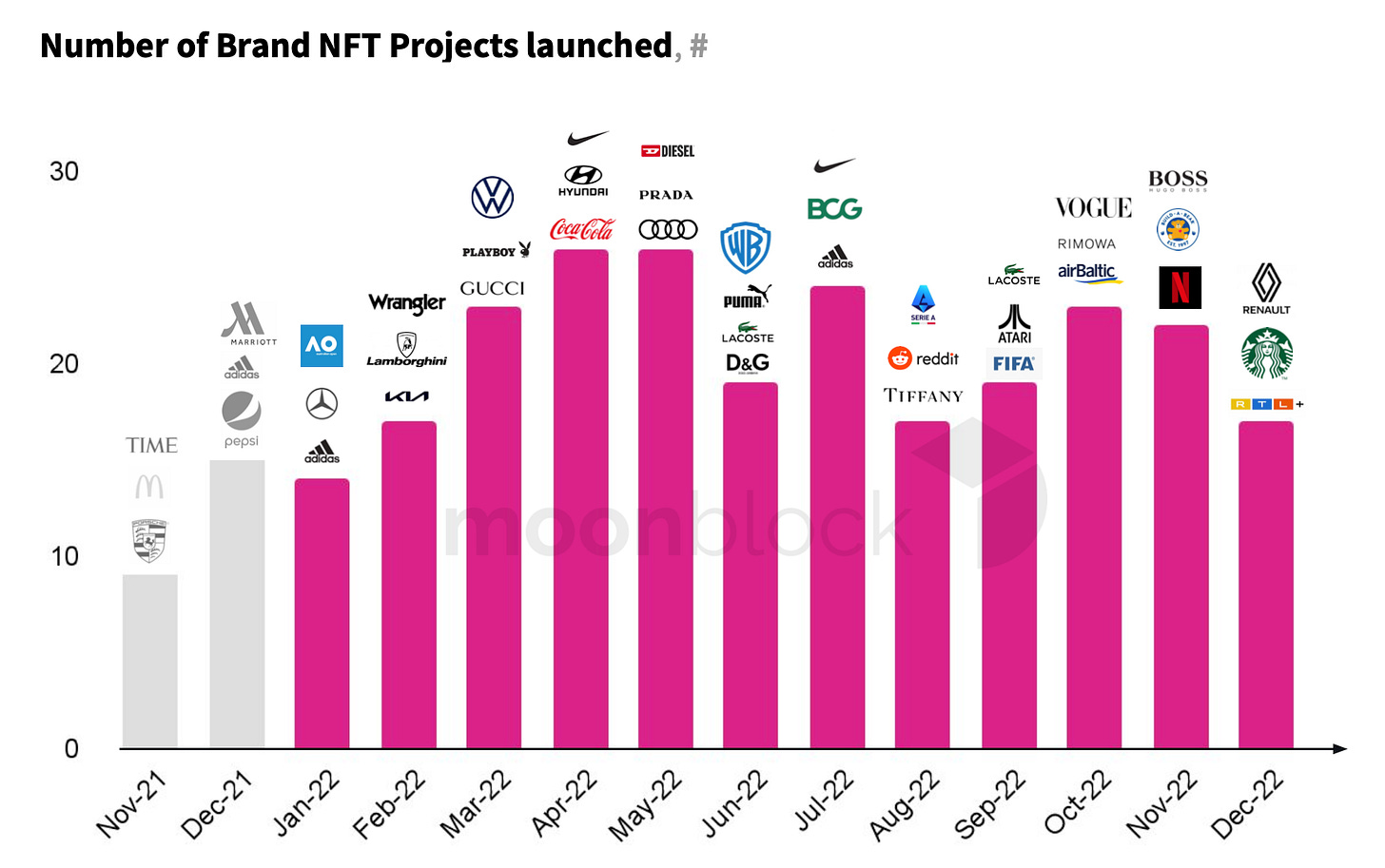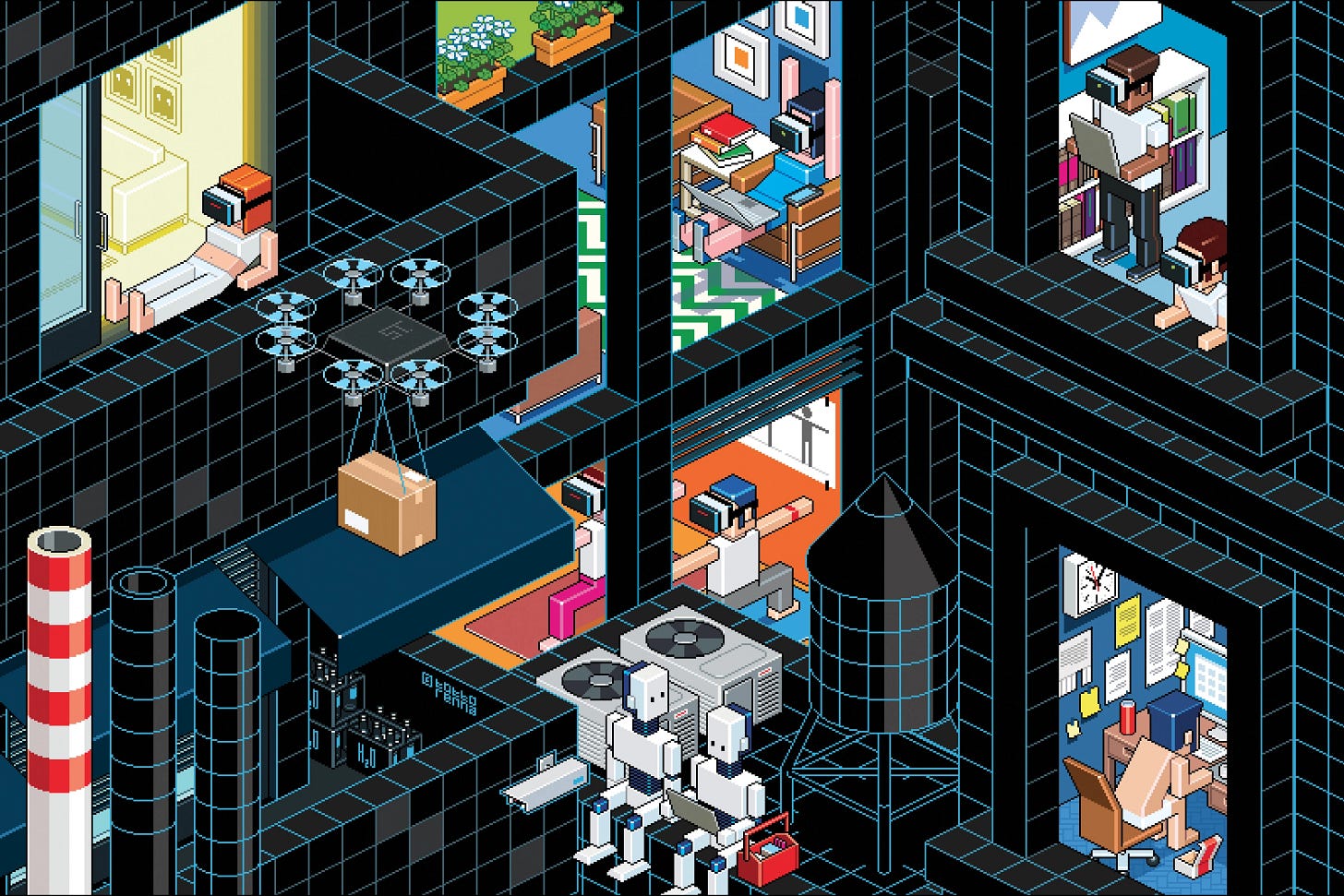The Web3 Opportunity: What's Next
The Web3 opportunity, catalysts for 2023, and why every brand needs to start thinking about it now.
2022 was the year of “Web3” and the “Metaverse”.
As a result of the hype, people started using the terms inflationary until they became almost meaningless buzzwords.
Jay-Z and “Ye” would say: “No one knows what it means… but it’s provocative… it gets the people going!”
It’s true.
Among marketers, it became en vogue to have a “Web3 strategy” or to “have a presence in the Metaverse”. The media fueled the hype further.1 Even Time Magazine was carried away by it: “Into the Metaverse: The Next Digital Era Will Change Everything”, it titled in July 2022.2
As we approach the end of 2022, nobody knows exactly what they mean, or even how they differ. For some, Web3 is Bitcoin. Or cryptocurrencies. Or a scam. Or an unnecessary buzzword as often heard in nascent industries. Or the next version of the internet. Or the matrix. Or the Metaverse. Often, the terms are used interchangeably.
Also, people’s expectations about it differ wildly. It’s comparable to the internet in the early 90s. It varies from "it will change everything" to "it's the most unnecessary thing since Segways or Google Glasses".3
Spoiler alert: “Web3” and “Metaverse” are two separate things, even though they’re tightly related. And their potential is huge.
VC investments in Web3 in 2021 exceeded $32.4 billion in 2021. McKinsey expects the Metaverse to have $5 trillion in value by 2030. It’s “potentially the biggest new growth opportunity for several sectors in the coming decade”, they write.4
Over 30% of Interbrand’s best global brands have already entered Web3.

You can’t ignore this.
What’s Web3?
TLDR; Web3 is a vision of an open, equitable web.
The term “Web3” was coined by Gavin Wood in 2014. He talked about “web1”, starting off with the idea of an open and decentralized internet. Web2 — the internet we know today — then led to the birth of monopolistic platforms that have a strong influence over the internet and own a lot of the infrastructure the web is built on.
It became a major narrative that we move from
web1 (read)
to web2 (read + write)
to web3 (read + write + own).
Here’s an excellent summary from
on what’s happening with Web3:Decentralization of power — There is increasing mistrust in concentrated power. Whether it is government, central banks, or global omegatech corporations that have become more powerful than nations. The trend of deplatforming, behavioural mandates and censorship has created new interest in building trustless and censorship-resistant platforms that can empower ordinary people and fractionate existing power structures.
Ownership of value — With Web2, the web changed from “read” to “read and write”. The web became social and participative; the age of user-generated content began. Modern tech companies host content sourced from users and then monetize it privately. They exploit our desire for social interaction and compound them with addictive product-patterns, interweave adverts and extract all of this user-generated value for shareholders. By the time you’re able to to become a shareholder in these companies, they’re already valued at multiple billions and insiders already got rich.
What the heck is “ownership of value”?
Simply said, digital files can now be put onto the blockchain, an immutable, decentralized open-data structure that anyone can write to and read from.5 On the Internet, every file that is “shared” (e.g. sent via email) was actually “duplicated” from server to server and owned by some centralized platform (e.g. email hosting service). Now, files are easily transferred, from owner to owner, without any centralized platform.
That’s possible thanks to NFTs, or “non-fungible tokens”. NFTs enable a standardized universal digital representation and ownership layer for any natively digital “thing” such as game assets, digital art, or domain space. With NFTs ownership and authenticity can be transparently managed.
Blockchain & NFTs level-up the internet with three new revolutionary features:
Digital ownership
Transferability
Permanent data storage
This has led to novel concepts like the “ownership economy”, meaning that creators can actually own and monetize their assets instead of locking them away on platforms.6 According to a16z, Web3 paid out $174,000 per creator in 2021, while Meta paid out $0.10 per user, Spotify paid out $636 per artist, and YouTube paid out $405 per channel. “Web3 is tiny but mighty”, they add.7
a16z often speaks about the “take-rate”:8
The take-rates of web2 giants are extortionate; web3 platforms offer fairer economic terms. In 2021, primary sales of Ethereum-based NFTs (ERC-721 and ERC-1155), plus the royalties paid to creators from secondary sales on OpenSea, yielded a total of $3.9 billion. That’s quadruple the $1 billion – less than 1% of revenues – that Meta has earmarked for creators through 2022.
Web3 technology also enables to create digital, portable identities. According to data privacy startup, Mine, the average consumer’s personal data is held by 350 different brands. Instead of tying one’s identity to a specific platform (“in-platform identities”), identities can now become portable, interoperable, and self-sovereign, disentangled platform relationships from real world identity except where absolutely necessary.
This could enable users and creators break free from the inevitable cyclical rise and fall of social protocols (cf. Google"+, MySpace, Digg, …) and protect themselves from data breaches.
The promise of Web3 wallets is the ability for people to take their data with them and share it with – or even sell it to – brands and companies they trust.
Here’s a great comparison between the Web2 and Web3 paradigms:

Web3 critics argue that it’s either a fad no one needs or a giant Ponzi scheme. Others believe in the vision, but contend that true decentralization is impossible at scale.
Web3 optimists argue that users will prefer credibly neutral platforms that lack altogether the capacity for arbitrary censorship, undue rent extraction (also in the form of privacy costs), or sudden cessation. They see Web3 as a self-sovereign internet of value with an open creator economy and a universal digital ownership layer via NFTs. They see it as the future of a more open, equitable internet.
The optimist in me always wins.
The Metaverse is not Web3
The majority of people describes the “Metaverse” as collective virtual worlds with advanced AR/VR visualization, persistent digital objects, and immersive experiences (in whatever form). It is a concept that originated in science fiction.
There’s a consensus that the Metaverse will be:9
Virtual and physical combined
Social, but with an individual sense of presence
Interoperable
Data persistent (for things as identity, digital assets, etc.)
When brands speak about the “Metaverse”, like Adidas, they usually mean a mix of all those concepts.
For some, such as Mark Zuckerberg, the Metaverse is not necessarily decentralized, but just a virtual experience. This is usually referred to as the “closed” metaverse.10

The big thesis: Across the internet, time spent in virtual spaces increases, particularly among Gen Z and millennials. According to McKinsey, the share of millennials excited about the metaverse is 40 percent higher than that of Gen Z. More time spent online will lead to more value created and consumed digitally.
I argue that the “Metaverse” will eventually combine several technologies to create those experiences:
AI
AR/VR
Web3
JPMorgan is on point:
The elements of a new digital age are converging at scale. The metaverse is the driving force bringing these elements together in a unified, immersive experience.
Web3 will be an invaluable building block for the metaverse.11
The Web3 opportunity for brands, creators and users
Let’s recap. Here’s a quick rundown of the big shifts that are happening:
We move from web1 (read) to web2 (read + write) to web3 (read + write + own).
Digital ownership becomes possible thanks to blockchains; they enable digital ownership, transferability, permanent data storage. This will potentially change the monetization model of the internet.
We see an ongoing increase of time spent on virtual spaces, particularly among Gen Z and millennials.
We see new immersive experiences due to convergence of technologies at scale (AR/VR, AI, Web3, etc.).
This creates opportunities for brands to innovate, market, build client relationships, foster communities, or co-create in entirely new ways; and for users to claim back control of their data.
This is why folks are talking about the “Web3 opportunity”.
Let’s make that more concrete.
I see the following Web3 use cases for brands & creators:
Amplify customer and brand experiences (e.g. Philipp Plein launched its world first crypto concept store, bought Plein Plaza, a piece of Land in Decentraland for $1.4 million, to experience the brand; From storytelling to “storyliving”: Panerai issues NFTs in exchange for experiences money can’t buy; or Balmain’s NFT membership program)
Building communities (e.g. the Club Soda 3.0 community by Scotch & Soda; Netflix rented space in Decentraland to bring fans into a maze as a promotion for the film “The Gray Man.”)
Enable co-creation (e.g. Nike partnered with RTFKT and collaborated with 19 emerging artists to launch the Space Drip NFT collection).
Access new customer groups such as digital natives, Gen Z & millennials or Web3 communities (e.g. M&Ms partnered with BAYC to create limited editions M&Ms).
Monetize IP (e.g. Atari, in celebration of their 50th anniversary, launched an NFT collection as well as a metaverse experience, Room 133).
Representation / fractionalization of assets
Verifiability, provenance, and reduction of counterfeiting through digital twins on the blockchain (LVMH, Prada Group and Cartier founded the Aura Blockchain Consortium; Arianee, an independent company, has similar ambitions).
Creation of verifiable rarity
Recurring revenues on royalties & commissions beyond first sale
Loyalty (e.g. Starbucks Odyssey)
I see the following Web3 use cases for users:
Keep reading with a 7-day free trial
Subscribe to 51 Insights to keep reading this post and get 7 days of free access to the full post archives.



